|
The
Railroad War of 1844
The Long Island Railroad came to
Yaphank in 1844. Before the railroad, a stage carrying passengers and mail
took 2 ˝ days to reach the middle of the island.
When the railroad was completed,
it was received with anticipation that great changes would come with it. You
could now travel from Yaphank to NYC in a stunning two hours. Mr. Pfeiffer
could now take his wagon to Yaphank and pick up an order and bring it back
to his Middle Island general store. By 1890, you could go to the Yaphank
freight office and place an order from a Sears or Montgomery Ward catalog.
The order filled and shipped back to the freight station. The Amazon of its
day.
The railroad would also bring
some unforeseen problems for our farmers. One of the most valuable assets
for a farmer was his woodland and the cordwood it produced. Many farmers
including William Weeks of Yaphank hired laborers to cut cordwood to be sold
in the city and elsewhere. Wood was king for much of Long Island.
It began in a dry period in April
and May when sparks from passing locomotives caused forest fires. In May
100,000 acres of timber was destroyed. These fires would often sweep in
whatever direction the wind blew and a fire that started in Manorville could
make its way to Rocky Point before being controlled. Robert Randall of Ridge
lost 1000 cords of firewood to one of the fires. The estimated loss of his
firewood amounted to $2,500.
So, the farmers appealed to the
LIRR for redress, but their pleas fell upon deaf ears. It wasn’t long before
threats replaced appeals. Local farmers loaded their wagons with men
and tools and began lifting rails along the tracks. Not wanting to injure
passengers a huge bushy pine tree was felled across the track giving warning
for the engineer.
In a show of force the railroad
responded by arming laborers to guard the tracks. Undaunted, the farmers of
our area took the tracks off near Calverton causing a locomotive to leave
the track and settle in a swampy area. The next attack on a train was at the
Carmen's River bridge.
One night, a single armed guard
was inspecting the track line when he was approached by two armed farmers.
As he stopped about 100 armed men emerged from the woods. He was soon
relieved of his weapon and sent back to the station. He was told to please
extend an invitation to the rest of his company and if they were to come
they would find out just how handy the farmers were with shotguns and
crowbars. That was the last guard that ever passed down the track.
With a significant loss in
ridership and money the LIRR decided to settle. They paid money to the
farmers for the destroyed woodland and in other cases agreed to pay for the
destroyed cordwood.
Who were these farmers that took
on the mighty railroad? Some of them had Revolutionary War blood flowing in
their veins as their fathers had served during the Glorious Rebellion. The
names of the men who participated were never divulged and no written stories
of their actions were ever found. All that was ever mentioned of the
participants was that they were some of the most respected members of the
community. Credit to Paul Infranco
|
|

Emery map Yaphank MP58-59 - 10/1957

Emery map Yaphank MP58-59 - 10/1957
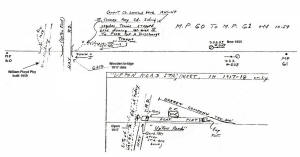
Emery map Yaphank MP60-61 - 10/1957

Emery map CU Jct. MP62-63 10/1957
Emery Yaphank maps: Archive: Dave Keller 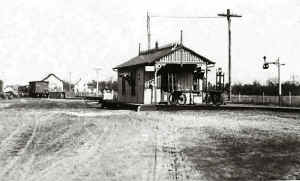
Yaphank depot c.1900 view SE
Archive: Dave
Keller
|

The baggage wagon on the platform reads "Long
Island Express"
that was in business from 1882 to 1913.
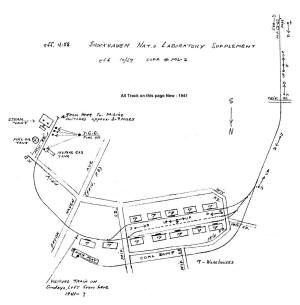
Emery map Supp ML-2 Brookhaven National Lab 10/1957 Archive: Dave Keller
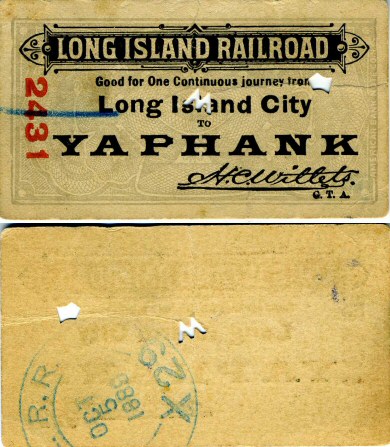
Ticket LI City to Yaphank 10/05/1889
Archive: Dave Keller |
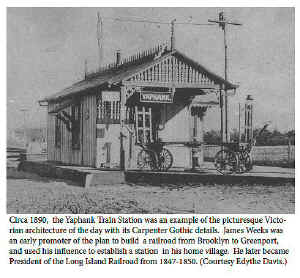
Yaphank depot c.1890 view SE close-up 
LIRR map - Yaphank 6/1966 Page 70
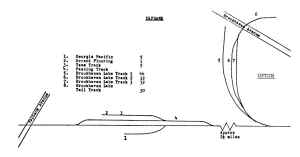
LIRR map - Yaphank 1986 Page 56 Archive: Jeff
Erlitz
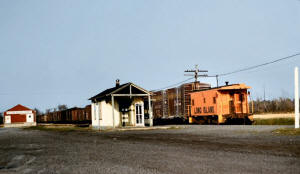
Yaphank Station Caboose #51 on eastbound freight
View SE 4/24/1959 Source: eBay |
|
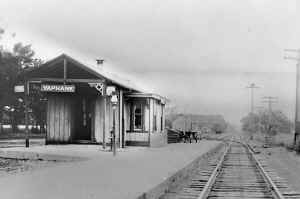
LIRR valuation photo 1921 Yaphank depot
view E
Archive: Dave
Keller |

Yaphank Station - View E c.1947
(Smith-Morrison)
|
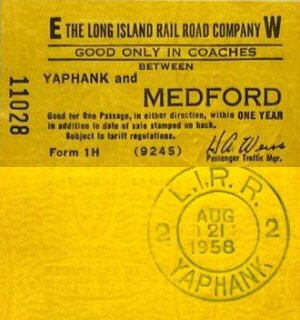
Ticket between Yaphank-Medford - GPA Weiss 8/21/1958
Archive: Jerry Landesman
|

Special train to Camp Siegfried, Yaphank
View SW c.1930's
|
During the early to mid-1930's, the German-American
Bund met at Camp Siegfried, Yaphank for outdoor events and speeches made by
Nazi-American leaders followed by picnic lunch and traditional German music.
Yaphank had a rather large German community and the streets near the camp
had Nazi-related names during this era. Photo right.
Special trains ran to Yaphank carrying
Nazi-Americans from other parts of Long Island and the metropolitan NY
area. The photographer appears to be standing on the old baggage wagon
as he captured this elevated image looking southwest as one of those
specials arrived at the station, being welcomed by many followers of Herr
Hitler. Photo left. Research: Dave Keller
|

Adolf Hitler Strasse (street) c.1930's
Camp Siegfried, Yaphank
|
|
“YA”
YAPHANK
(1878 BOOK OF RULES AND 1903 CR4) TRAIN ORDER OFFICE IN TICKET OFFICE. BLOCK
OFFICE IN SVC: 5/28/18.
UNATTENDED BLOCK STATION SIGNAL IN SVC: 5/23/28.
PERMISSIVE BLOCK ASPECT ADDED TO BLOCK SIGNALS: 6/25/28. BLOCK OFFICE IN
STATION OUT OF SVC: 9/2/58.
BLOCK LIMIT STATION SIGNAL IN SVC: 9/2/58 Research: Dave Keller
|
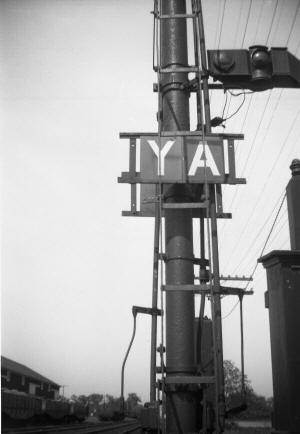
YA block signal - View E c.1947
Photo: Harold Smith Archive: Dave Morrison
Note: Western Suffolk Produce Potato House
on team track at far left.
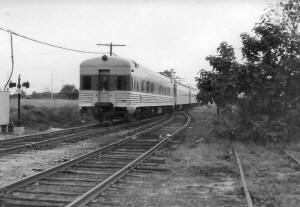
AQUEBOGUE westbound at Yaphank
8/1971 Photo/Archive: William H. Birkholz |
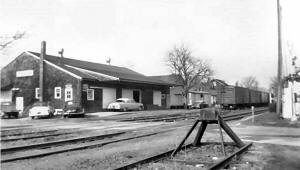
Western Suffolk Produce Potato House - View NE
c.1952
(Emery-SUNY-Stony-Brook)

Yaphank Station view E at night 10/1952
Archive: Simcha Hellinger

Ex-Western Suffolk Produce Potato
House View N
4/03/2018 Photo/Archive: Steve Rothaug |

Yaphank, Friday, August 18, 1972. The L-63 with RS-3
1555 is clear of the main well in advance of the YA time of #212. 212 had
two parlor and four coaches behind RS-3 1552. Info/Photo/Archive: Richard F
Makse
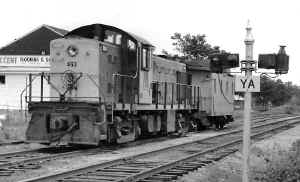
RS-1 #463 YA, Yaphank View NE at Accent Flooring
1970 Photo/Archive: William H. Birkholz
Note: Rear engine unit truck derailed |

B&A #74 west of Yaphank c.1973 Photo/Archive: William H. Birkholz |
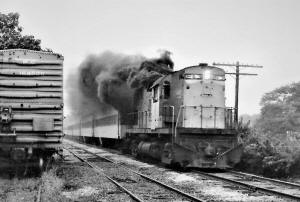
Shelter Island Express LIRR #213 westbound at Yaphank
c.1973 Photo/Archive: William H. Birkholz |
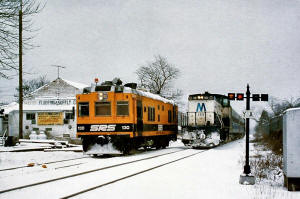
Sperry #130 YA, Yaphank - View NE 2/2020 Photo: MTA/LIRR
The Sperry Rail Car, a bright yellow, self-propelled
train car equipped with ultrasonic and induction test equipment that detects
internal rail defects not visible to the naked eye, has been a longstanding
and crucial component of our efforts to ensure the continued safety and
reliability of the rails. This scene was captured in Yaphank, back in 1992,
during a snowy winter season, and depicts the Sperry Rail Car having moved
to a siding to let a westbound train pass. Photo by Paul H. Espersen,
courtesy of our friends at the Long Island Sunrise Trail Chapter of the
National Railway Historical Society. |
|
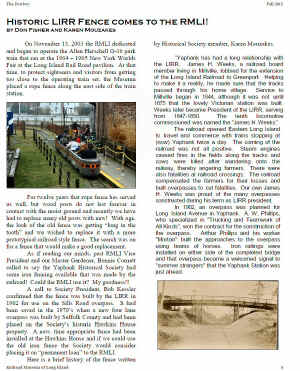
|

|
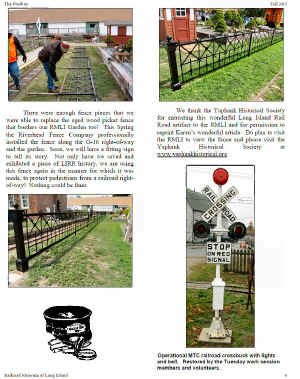
|
|
Historic LIRR Fence comes to the RMLI
- Fall 2015 Postboy pages 4-6 Courtesy: Yaphank
Historical Society
|

"Yaphank" by Arcadia Press
Courtesy: Yaphank Historical Society
|

LIRR Yaphank Fan Trip 11/05/61
Photo/Archive: Brad
Phillips

Yaphank shelter c.1960's
Archive: Dave Keller
|

Yaphank 10/08/2006 Photographer: Unknown
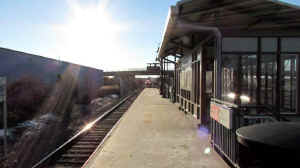
Yaphank 001/03/2013
Photographer: Unknown
|

Conrail - High or Wide Load Hold form to
Georgia-Pacific, Yaphank 12/21/1981 Archive: Bob Bender
"High and wide" or out-of-dimension (OOD) cars are cars that exceed certain dimensions that can be allowed within a specific portion of that railroad. I don't know how it's figured out now but there used to be a guide from the AAR called an equipment register and it had to fit within the dimensions of a certain size to be classified Plate A, B or C, if I recall. That specific one you posted listed "C. Hill" and I'm guessing thats Cedar Hill in New Haven, CT. Cedar Hill was the old New Haven RR's big freight yard just before hitting what used to be the limits of their catenary, so it would've been vital to them that the rail car wasn't high enough to arc to or strike the wire. They also couldn't be too wide so you wouldn't have a sideswipe in two or more track territory, again the NH had a few curves that were notorious for tight clearances, such as the Jenkins Curve in Bridgeport. Any exceptions of this would either be moved in the middle of the night with no adjacent traffic, on another route or not at all.
Certain portions of the LI have height restrictions, for example the Atlantic Branch west of Dunton, under the subway bridge at Pond, etc. So a move with a OOD car would be done very carefully and are often associated with parts of electric company parts, such as tranformers, etc. Another thing mentioned is "lading", which is how things are loaded into a car such as a gondola, such as railroad ties, etc. The loaded car must fit within the limits set by the railroad the car is coming into, and the employees are taught to watch out for lading that has shifted out of the dimensional limits. An example of lading that has shifted is when Nassau Tower got struck back in the 1920's which gave the tower a haircut, I'm sure many of you have seen that picture somewhere...
|
|
|
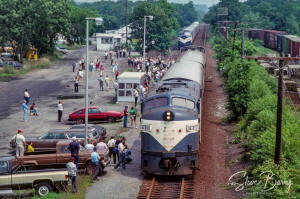 |
A Long Island westbound train pauses
at the Yaphank station behind "power pack" 621. The power pack is a cab car
that began life as Baltimore & Ohio 955A in 1952; as a power pack, it has no
traction motors to propel the train, but can provide head-end power to the
coaches. The crowd on the platform is off a charter train for the National
Railway Historical Society convention; that train, with a power pack
converted from an FA locomotive, is in the siding, allowing the regular
service train to pass. After leaving the Long Island, the 621 moved to
Florida to work for the Seminole Gulf.
NRHS fantrip - Yaphank view E FA #621 Photo/Archive: Steve Berry |
YAPHANK - APRIL 3. 2018
Photos: Steve Rothaug
|
|
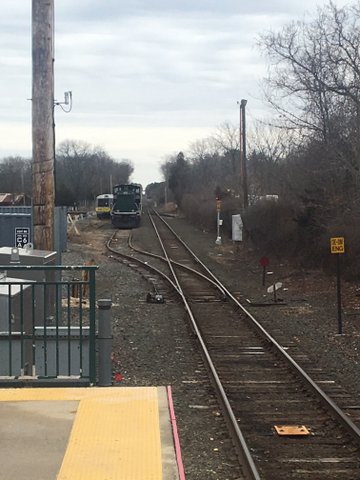
Yaphank Station View E
|
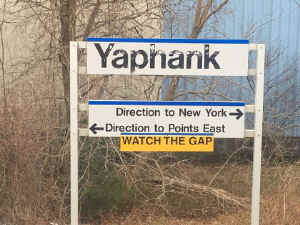
LIRR Yaphank Station sign
|
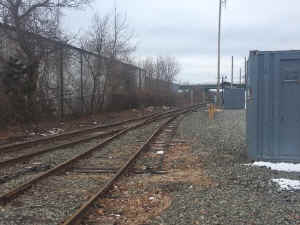
Yaphank Station View W
|